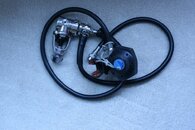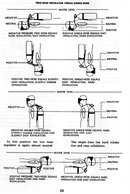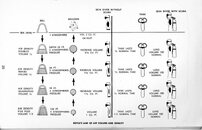James,
I think that my A.I.R. I regulator by Scubapro will out-perform the D400, as the diaphragm is the exhalation valve, and it's oriented opposite, up instead of down.
Now, concerning the op-ed's question, here's the original diagram by Bill Barada and published in Let's Go Diving, U.S. Divers Company, 1962. Bill had some interesting things to say, and remember he wrote this in the early 1960s.
SeaRat
I think that my A.I.R. I regulator by Scubapro will out-perform the D400, as the diaphragm is the exhalation valve, and it's oriented opposite, up instead of down.
Now, concerning the op-ed's question, here's the original diagram by Bill Barada and published in Let's Go Diving, U.S. Divers Company, 1962. Bill had some interesting things to say, and remember he wrote this in the early 1960s.
I. SELECTING A REGULATOR
The regulator is probably the most important single piece of equipment selected by a diver. The choice should be made with extreme care, to be sure its breathing characteristics are adequate to meet the individual's requirements. Air consumption increases in proportion to depth and exertion. An inexpensive regulator, adequate for shallow water sport diving, is often incapable of delivering the amount of air required by a diver working in comparatively deep water. The internal mechanism and design determine air flow and suction characteristics in either single or double hose regulators, and performance cannot be determined by "test breathing" in the air or in a swimming pool. Prefossional perfarmance can only be measured by sensitive laboratory instruments, which calibrate the suction effort required in order to obtain the necessary flow of air. "AQUA-LUNG" regulators are available from the manufacturer..."
SeaRat






